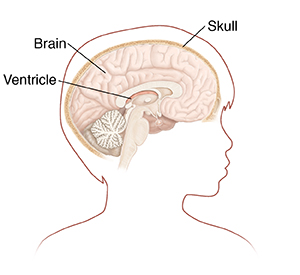Treatment for Skull Fracture (Child)

A skull fracture is a type of head injury. It is a break in the skull bone. Fractures range from mild to severe and can have different symptoms. Some fractures are just a hairline. Others are more serious with bone fragments lodged in the brain, or a blood clot pushing on the brain.
Types of treatment
Treatment depends on how bad the injury is. Treatment for a mild injury may include:
A cut from the injury may be treated with antibiotic ointment and a bandage. A large cut may be closed with staples or stitches. If the cut is deep, your child might need antibiotics, especially if the cut goes down to the fracture.
A more serious injury may mean your child needs treatment right away. Or your child may need to stay in the hospital to be watched. In some cases, a child may need:
-
Medicine to help them relax and sleep.
-
To be closely watched in the intensive care unit.
-
Help with breathing by using a breathing machine (mechanical ventilator).
-
Tests to find out how serious the injury is, such as a CT, MRI, or an EEG.
-
Surgery.
Your child may need to see a traumatic brain injury specialist. This type of health care provider can watch for and treat postconcussive syndrome. This is a complex set of symptoms that can occur after a head injury.
Watching intracranial pressure (ICP)
A head injury may cause the brain to swell. Because the brain is covered by the skull, there is only a small amount of room for it to swell. This causes pressure inside the skull to increase. The pressure inside the skull is known as intracranial pressure (ICP). Too much ICP can lead to brain damage.
Your child’s ICP may need to be measured in the hospital. ICP can be measured with 2 small devices:
-
An external ventricular drain. This is a small hollow tube (catheter) placed into the fluid-filled space in the brain (the cerebral ventricles).
-
A small wire device placed through a bolt fixed to the skull into the space just between the skull and the brain, or directly in the brain.
One or both of these devices may be put in place by the provider in the hospital. It is then attached to a monitor. This gives a constant reading of the pressure inside the skull. If the pressure goes up, it can be treated right away.
While the ICP device is in place, your child will be given medicine to prevent pain. The device will be removed when it is no longer needed.
Living with brain injury
In some cases, a child who has a severe brain injury may lose some muscle function (paralysis), speech (aphasia), vision, hearing, or taste. This depends on the area of the brain that is damaged. A child may also have changes in personality or behavior. These changes may get better, or they may last for a long time. Brain injury symptoms may need lifelong treatment. It may include medicine. It may also include physical, occupational, or speech therapy.
You can help your child by focusing on their abilities at home and in the community. Be positive about their skills. This will help your child to have self-esteem and independence. Work with your child’s provider.
Preventing skull fracture
You can help create a safe playing environment for your child. This can help to prevent a head injury. Make sure to have your child:
-
Wear a seatbelt in the car or any other vehicle.
-
Wear a helmet for activities, such as bike riding, skating, and skateboarding.
-
Wear a helmet whenever they are outside, if your child has severe epilepsy or other diseases that put them at high risk of falling.
When to contact your child’s doctor
Contact the provider if:
Call 911
Call 911 if:
-
Your child vomits.
-
Your child has a severe headache.
-
Your child has trouble walking.
-
Your child has eyesight or hearing problems.
-
Your child feels weak or numb.
-
Your child is acting differently from normal.
-
Blood or fluid is leaking from your child's nose or ear.
-
Your child loses consciousness.